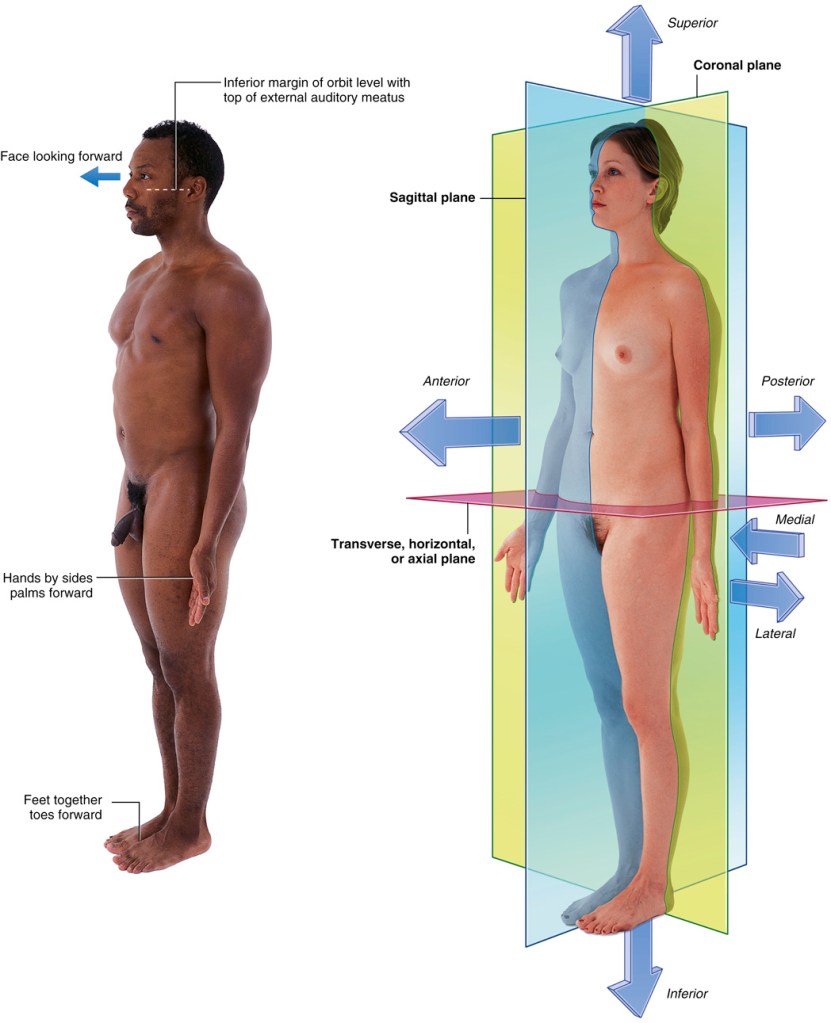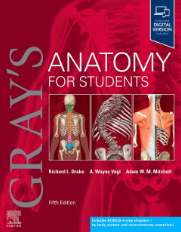The anatomical position is the standard reference position of the body used to describe the location of structures (Fig. 1.1).
The body is in the anatomical position when standing upright with feet together, hands by the side, and face looking forward. The mouth is closed and the facial expression is neutral. The rim of bone under the eyes is in the same horizontal plane as the top of the opening to the ear, and the eyes are open and focused on something in the distance. The palms of the hands face forward with the fingers straight and together and with the pad of the thumb turned 90 degrees to the pads of the fingers. The toes point forward.

FIG 1.1: The Anatomical Position, Planes, and Terms of Location and Orientation. Adapted from Drake, Mitchell & Vogl. Gray’s Anatomy for Students, 5th Ed. 2024. © Elsevier.
Anatomical planes
Three major groups of planes pass through the body in the anatomical position (see Fig. 1.1).
▪ Coronal planes are oriented vertically and divide the body into anterior and posterior parts.
▪ Sagittal planes also are oriented vertically but are at right angles to the coronal planes and divide the body into right and left parts. The plane that passes through the center of the body dividing it into equal right and left halves is termed the median sagittal plane.
Terms to describe location
Anterior (ventral) and posterior (dorsal), medial and lateral, superior and inferior
Three major pairs of terms are used to describe the location of structures relative to the body as a whole or to other structures (see Fig. 1.1).
▪ Anterior (or ventral) and posterior (or dorsal) describe the position of structures relative to the “front” and “back” of the body. For example, the nose is an anterior (ventral) structure, whereas the vertebral column is a posterior (dorsal) structure. Also, the nose is anterior to the ears and the vertebral column is posterior to the sternum.
▪ Medial and lateral describe the position of structures relative to the median sagittal plane and the sides of the body. For example, the thumb is lateral to the little finger. The nose is in the median sagittal plane and is medial to the eyes, which are in turn medial to the external ears.
▪ Superior and inferior describe structures in reference to the vertical axis of the body. For example, the head is superior to the shoulders and the knee joint is inferior to the hip joint.
Proximal and distal, cranial and caudal, and rostral
Other terms used to describe positions include proximal and distal, cranial and caudal, and rostral.
▪ Proximal and distal are used with reference to being closer to or farther from a structure’s origin, particularly in the limbs. For example, the hand is distal to the elbow joint. The glenohumeral joint is proximal to the elbow joint. These terms are also used to describe the relative positions of branches along the course of linear structures, such as airways, vessels, and nerves. For example, distal branches occur farther away toward the ends of the system, whereas proximal branches occur closer to and toward the origin of the system.
▪ Cranial (toward the head) and caudal (toward the tail) are sometimes used instead of superior and inferior, respectively.
▪ Rostral is used, particularly in the head, to describe the position of a structure with reference to the nose. For example, the forebrain is rostral to the hindbrain.

